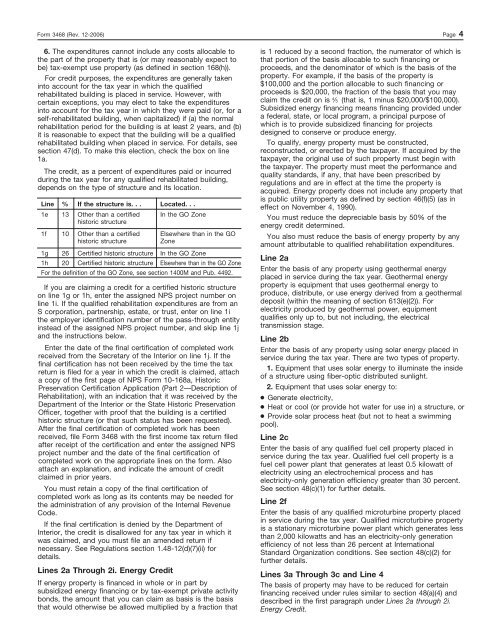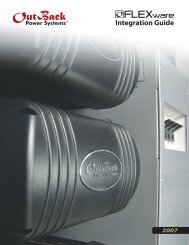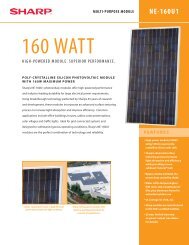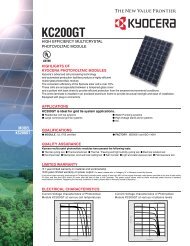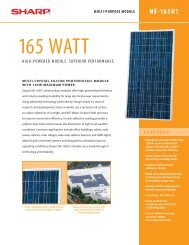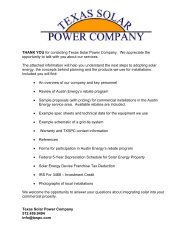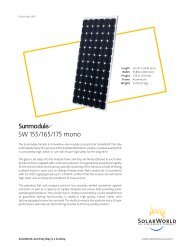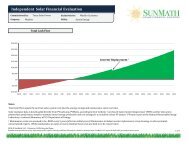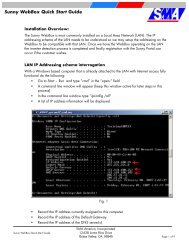THANK YOU for contacting Texas Solar Power Company. We ...
THANK YOU for contacting Texas Solar Power Company. We ...
THANK YOU for contacting Texas Solar Power Company. We ...
Create successful ePaper yourself
Turn your PDF publications into a flip-book with our unique Google optimized e-Paper software.
Form 3468 (Rev. 12-2006) Page 4<br />
6. The expenditures cannot include any costs allocable to<br />
the part of the property that is (or may reasonably expect to<br />
be) tax-exempt use property (as defined in section 168(h)).<br />
For credit purposes, the expenditures are generally taken<br />
into account <strong>for</strong> the tax year in which the qualified<br />
rehabilitated building is placed in service. However, with<br />
certain exceptions, you may elect to take the expenditures<br />
into account <strong>for</strong> the tax year in which they were paid (or, <strong>for</strong> a<br />
self-rehabilitated building, when capitalized) if (a) the normal<br />
rehabilitation period <strong>for</strong> the building is at least 2 years, and (b)<br />
it is reasonable to expect that the building will be a qualified<br />
rehabilitated building when placed in service. For details, see<br />
section 47(d). To make this election, check the box on line<br />
1a.<br />
The credit, as a percent of expenditures paid or incurred<br />
during the tax year <strong>for</strong> any qualified rehabilitated building,<br />
depends on the type of structure and its location.<br />
Line<br />
1e<br />
1f<br />
1g<br />
1h<br />
%<br />
13<br />
10<br />
26<br />
20<br />
If the structure is. . .<br />
Other than a certified<br />
historic structure<br />
Other than a certified<br />
historic structure<br />
Certified historic structure<br />
Certified historic structure<br />
For the definition of the GO Zone, see section 1400M and Pub. 4492.<br />
If you are claiming a credit <strong>for</strong> a certified historic structure<br />
on line 1g or 1h, enter the assigned NPS project number on<br />
line 1i. If the qualified rehabilitation expenditures are from an<br />
S corporation, partnership, estate, or trust, enter on line 1i<br />
the employer identification number of the pass-through entity<br />
instead of the assigned NPS project number, and skip line 1j<br />
and the instructions below.<br />
Enter the date of the final certification of completed work<br />
received from the Secretary of the Interior on line 1j. If the<br />
final certification has not been received by the time the tax<br />
return is filed <strong>for</strong> a year in which the credit is claimed, attach<br />
a copy of the first page of NPS Form 10-168a, Historic<br />
Preservation Certification Application (Part 2—Description of<br />
Rehabilitation), with an indication that it was received by the<br />
Department of the Interior or the State Historic Preservation<br />
Officer, together with proof that the building is a certified<br />
historic structure (or that such status has been requested).<br />
After the final certification of completed work has been<br />
received, file Form 3468 with the first income tax return filed<br />
after receipt of the certification and enter the assigned NPS<br />
project number and the date of the final certification of<br />
completed work on the appropriate lines on the <strong>for</strong>m. Also<br />
attach an explanation, and indicate the amount of credit<br />
claimed in prior years.<br />
You must retain a copy of the final certification of<br />
completed work as long as its contents may be needed <strong>for</strong><br />
the administration of any provision of the Internal Revenue<br />
Code.<br />
If the final certification is denied by the Department of<br />
Interior, the credit is disallowed <strong>for</strong> any tax year in which it<br />
was claimed, and you must file an amended return if<br />
necessary. See Regulations section 1.48-12(d)(7)(ii) <strong>for</strong><br />
details.<br />
Lines 2a Through 2i. Energy Credit<br />
Located. . .<br />
In the GO Zone<br />
Elsewhere than in the GO<br />
Zone<br />
In the GO Zone<br />
Elsewhere than in the GO Zone<br />
If energy property is financed in whole or in part by<br />
subsidized energy financing or by tax-exempt private activity<br />
bonds, the amount that you can claim as basis is the basis<br />
that would otherwise be allowed multiplied by a fraction that<br />
is 1 reduced by a second fraction, the numerator of which is<br />
that portion of the basis allocable to such financing or<br />
proceeds, and the denominator of which is the basis of the<br />
property. For example, if the basis of the property is<br />
$100,000 and the portion allocable to such financing or<br />
proceeds is $20,000, the fraction of the basis that you may<br />
claim the credit on is 4 ⁄ 5 (that is, 1 minus $20,000/$100,000).<br />
Subsidized energy financing means financing provided under<br />
a federal, state, or local program, a principal purpose of<br />
which is to provide subsidized financing <strong>for</strong> projects<br />
designed to conserve or produce energy.<br />
To qualify, energy property must be constructed,<br />
reconstructed, or erected by the taxpayer. If acquired by the<br />
taxpayer, the original use of such property must begin with<br />
the taxpayer. The property must meet the per<strong>for</strong>mance and<br />
quality standards, if any, that have been prescribed by<br />
regulations and are in effect at the time the property is<br />
acquired. Energy property does not include any property that<br />
is public utility property as defined by section 46(f)(5) (as in<br />
effect on November 4, 1990).<br />
You must reduce the depreciable basis by 50% of the<br />
energy credit determined.<br />
You also must reduce the basis of energy property by any<br />
amount attributable to qualified rehabilitation expenditures.<br />
Line 2a<br />
Enter the basis of any property using geothermal energy<br />
placed in service during the tax year. Geothermal energy<br />
property is equipment that uses geothermal energy to<br />
produce, distribute, or use energy derived from a geothermal<br />
deposit (within the meaning of section 613(e)(2)). For<br />
electricity produced by geothermal power, equipment<br />
qualifies only up to, but not including, the electrical<br />
transmission stage.<br />
Line 2b<br />
Enter the basis of any property using solar energy placed in<br />
service during the tax year. There are two types of property.<br />
1. Equipment that uses solar energy to illuminate the inside<br />
of a structure using fiber-optic distributed sunlight.<br />
2. Equipment that uses solar energy to:<br />
● Generate electricity,<br />
● Heat or cool (or provide hot water <strong>for</strong> use in) a structure, or<br />
● Provide solar process heat (but not to heat a swimming<br />
pool).<br />
Line 2c<br />
Enter the basis of any qualified fuel cell property placed in<br />
service during the tax year. Qualified fuel cell property is a<br />
fuel cell power plant that generates at least 0.5 kilowatt of<br />
electricity using an electrochemical process and has<br />
electricity-only generation efficiency greater than 30 percent.<br />
See section 48(c)(1) <strong>for</strong> further details.<br />
Line 2f<br />
Enter the basis of any qualified microturbine property placed<br />
in service during the tax year. Qualified microturbine property<br />
is a stationary microturbine power plant which generates less<br />
than 2,000 kilowatts and has an electricity-only generation<br />
efficiency of not less than 26 percent at International<br />
Standard Organization conditions. See section 48(c)(2) <strong>for</strong><br />
further details.<br />
Lines 3a Through 3c and Line 4<br />
The basis of property may have to be reduced <strong>for</strong> certain<br />
financing received under rules similar to section 48(a)(4) and<br />
described in the first paragraph under Lines 2a through 2i.<br />
Energy Credit.


